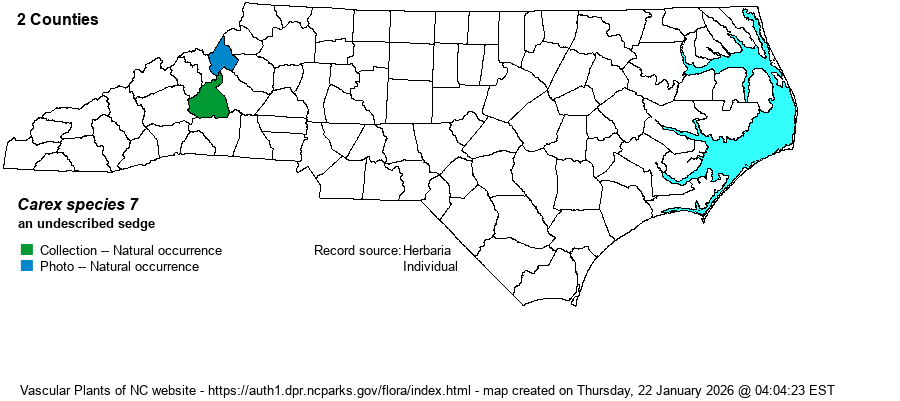| Author | | |
| Distribution | Apparently throughout most of the Mountains, and into the Piedmont (at least the upper and higher regions); range poorly known, as this is an undescribed species. Plants photographed along Bridge Trail on Grandfather Mountain by B.A. Sorrie; specimen collected and is awaiting verification from Derick Poindexter.
"Southern Appalachians and nearby, lower elevation provinces, the distribution still poorly known, probably VA and KY south to SC, GA, and AL" (Weakley 2022). | |
| Abundance | Weakley's (2022) map shows it as "common" in the Mountains and "uncommon" in the Piedmont. Considering its habitats, the species apparently is restricted in the Piedmont just to the western and higher elevation regions. | |
| Habitat | "Moderate to high elevation oak, acid coves, and other hardwood forests" (Weakley 2022). Fruiting plants found in June 17, 2023 on Grandfather Mountain at about 5100 feet, under Betula alleghaniensis, Rhododendron catawbiense, Abies fraseri. | |
| Phenology | Not given. | |
| Identification | Weakley's (2022) key has it close to Carex austrolucorum; both Carex species 6 and Carex species 7 are then very close in the key. Carex species 6 has "Beak of perigynium (0.5-) 0.6-1.3 mm long; hairs at base of the beak and below densely short-retrorse only on both surfaces", versus "Beak of perigynium (0.3-) 0.5-0.9 mm long; hairs at the base of the beak antrorse and those below either spreading, antrorse, or with retrorse hairs largely confined to one surface" for this second undescribed taxon. | |
| Taxonomic Comments | Not yet described.
The genus Carex is the largest in North America, and among the largest in the world. In temperate and boreal regions, Carex is often the dominant or co-dominant ground layer in many habitats. Seeds (achenes) are valuable food for birds and small mammals, while foliage is used by birds and mammals to make nests and as food by mammals. Species of Carex often look vastly different from one another -- spikes erect vs. drooping, tiny inflorescence vs. whopping, culms leafy vs. naked, perigynia beaked vs. beakless, stems densely bunched vs. single, etc. The genus has been divided into many sections (or groups), based on shared characters; some taxonomists have suggested that these be different genera, but that proves unworkable (so far). All Carex share the feature of a perigynium (an outer covering) which completely surrounds the achene (seed). This covering may fit tightly or loosely (like a small bladder), depending on which group or species. Details of perigynia shape, ornamentation, presence and size of beak, number of striations (or veins) are all important ID features. In recent years Rob Naczi and colleagues have stressed the importance of arrangement of perigynia -- whether spiral (3+ ranks) or distichous (2-ranked) -- and have named a number of new species as well as split off some older synonyms. Therefore, RAB's (1968) key, excellent for its time, can only be used in a general way today. Members of some sections of Carex are difficult to key out (notably Ovales, Laxiflorae, Griseae); this is in part due to variation among individuals of a species, or failings of the key. FNA has drawings of most species and some species may be found in two or more places within a key, to acount for variability. New species to NC, and new to science(!), continue to be found in NC. | |
| Other Common Name(s) | None | |
| State Rank | [SU] | |
| Global Rank | GNR | |
| State Status | | |
| US Status | | |
| USACE-agcp | | |
| USACE-emp | | |

